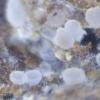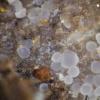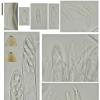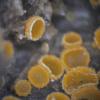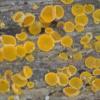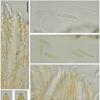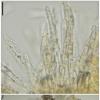
03-03-2014 19:08
Gernot FriebesHi, these two Arachnopezizas grew closely together

03-03-2014 22:15
for starters I have these items availablespores 11

05-03-2014 18:40
Ascocarp 1-3 mmin a rural area under Ulmus sp. and

04-03-2014 22:35
Hello,I found this orange fuiting body, 0,8mm, on

04-03-2014 14:55
Gernot FriebesHi,I'm looking for this paper:Voglmayr H., Rossman

04-03-2014 16:20
 Joop van der Lee
Joop van der Lee
Found on deer dung.Fruitbody; yellow; consisting o
Two Arachnopezizas
Gernot Friebes,
03-03-2014 19:08
these two Arachnopezizas grew closely together on a soaked, strongly decayed stump. One species has whitish, very small apothecia. The other species is much more distinct, having bigger, bright orange apothecia.
The smaller one (photos of this collection are attached to this post) has 0- to 1-septate ascospores measuring 11-16.5 x 3.5-4 µm without appendages but I could observe a hyalin sheath around one ascospore. Asci have croziers, they are IKI bb, paraphyses are simple, without any remarkable content. The hairs are smooth and tapering towards the apex.
I haven't been able to find a matching species but that may also be due to the fact that I do not possess Korf's monograph: Korf, R.P. 1951 A monograph of the Arachnopezizae. – Lloydia 14: 129-180, so if anyone has a digital version I'd very much appreciate it!
PS: I should add that the macro photos are not mine.
scale = 10 µm
Gernot Friebes,
03-03-2014 19:14
Re : Two Arachnopezizas
Here's the second species. I think it may be A. trabinelloides since it fits very well the various images and descriptions I've seen of this species. However I'm not entirely sure yet how to differentiate between A. trabinelloides and A. cornuta so any advice is welcome. Ascospores measure 13.5-18(19) x 3.2-3.8 µm, they usually have a thin middle septum but can become 3-septate when overmature. Again no appendages observed. Paraphyes are somewhat irregular and filled with tiny yellow droplets. Asci are IKI bb. Hairs show an irregular outline and are incrusted by a yellowish substance. Upon adding IKI the hymenium shows a distinctive blue-green colour reaction.
Best wishes, Gernot
scale = 10 µm
Best wishes, Gernot
scale = 10 µm
Stip Helleman,
04-03-2014 08:25

Re : Two Arachnopezizas
Hi Gernot,
I think trabinelloides is right aber mir fehlt die Zeit jetzt. I did send you a downloadlink for this Monograph.
Best,
Stip
I think trabinelloides is right aber mir fehlt die Zeit jetzt. I did send you a downloadlink for this Monograph.
Best,
Stip
Michel Hairaud,
04-03-2014 08:26

Re : Two Arachnopezizas
HI Gernot,
I will send Korf(s monograph to your mail adress in a minute
All best wishes
Michel
I will send Korf(s monograph to your mail adress in a minute
All best wishes
Michel
Michel Hairaud,
04-03-2014 08:31

Re : Two Arachnopezizas
Hi Stip,
Sorry I was a minute late this morning ,
''it's been a hard day's night'' ...
Amitiés à tous
Michel
Sorry I was a minute late this morning ,
''it's been a hard day's night'' ...
Amitiés à tous
Michel
Luc Bailly,
04-03-2014 10:59
Re : Two Arachnopezizas
Bonjour à tous, Hello,
I'd be interested in this monograph also.
Cheers - LUC.
I'd be interested in this monograph also.
Cheers - LUC.
Michel Hairaud,
04-03-2014 11:06

Re : Two Arachnopezizas
Regarde ds ta boite, Luc
Michel
Michel
Gernot Friebes,
04-03-2014 11:27
Re : Two Arachnopezizas
Hi Stip and Michel,
almost simultaneously. :-) Thanks a lot for the monograph!
Best wishes,
Gernot
almost simultaneously. :-) Thanks a lot for the monograph!
Best wishes,
Gernot
Luc Bailly,
04-03-2014 12:45
Re : Two Arachnopezizas
Ca va, je l'ai eu, merci Michel.
UZUN Yasin,
06-03-2014 14:46
Re : Two Arachnopezizas
http://www.mycoquebec.org/bas.php?trie=3&l=g&nom=Arachnopeziza%20cornuta%20/%20P%C3%A9zize%20cornue&tag=Arachnopeziza%20cornuta&gro=3
